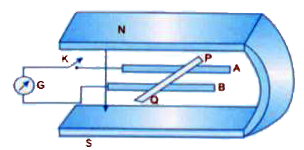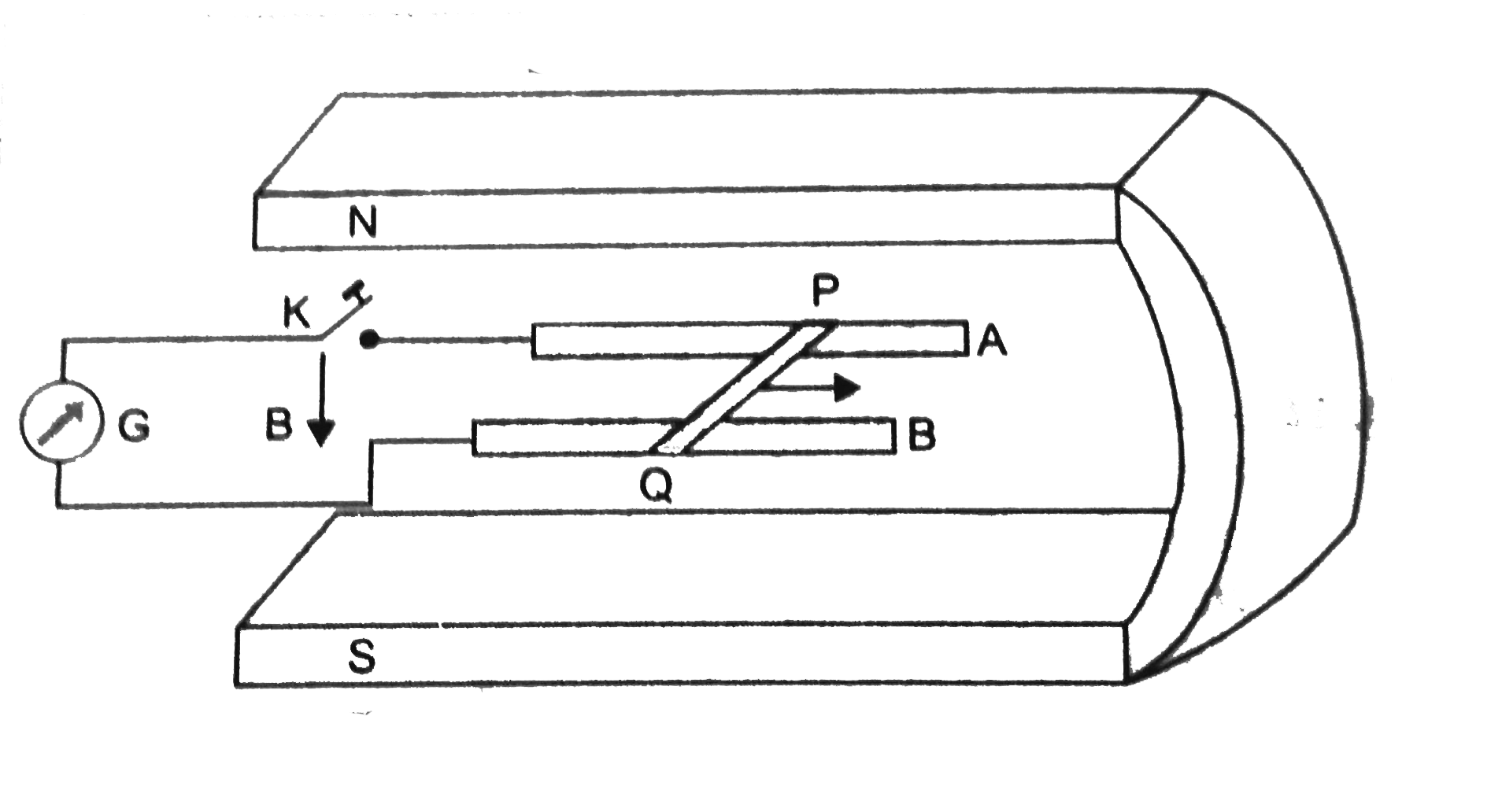A thin diamagnetic rod is placed vertically between the poles of an electromagnet. When the current in the electromagnet is switched on, then the diamagnetic rod is pushed up, out of the horizontal magnetic field. Hence the rod gains gravitational potential energy. The work required to do this comes from
The current source
The magnetic field
The lattice structure of the material of the rod
The induced electric field due to the changing magnetic field
The correct Answer is:A
Energy of current source will be coverted in to gravitational potential energy of the rod.
Topper's Solved these Questions
- BOOK - MTG GUIDECHAPTER - MAGNETIC EFFECTS OF CURRENT AND MAGNETISMEXERCISE - CHECK YOUR NEET VITALS25videos
MAGNETIC EFFECTS OF CURRENT AND MAGNETISM
- BOOK - MTG GUIDECHAPTER - ELECTROSTATICSEXERCISE - AIPMT/NEET (MCQ.s)34videos
ELECTROSTATICS
- BOOK - MTG GUIDECHAPTER - OPTICSEXERCISE - AIPMT/NEET55videos
OPTICS
Similar Questions
A thin diamagnetic rod is placed vertically between the poles of an electromagnet. When the current in the electromagnetic is switched on, then the diamagnetic rod is pushed up, out of the horizontal magnetic field. Hence the rod gains horizontal potential energy. the work required to do this comes from
View SolutionA small rod of bismuth is suspended freely between the poles of a strong electromagnet. It is found to arrange itself at right angles to the magnetic field. This observation establishes that bismuth is
View Solution
Knowledge Check
- Question 1 - Select One
A thin diamagnetic rod is placed vertically between the poles of an electromagnet. When the current in the electromagnetic is switched on, then the diamagnetic rod is pushed up, out of the horizontal magnetic field. Hence the rod gains horizontal potential energy. the work required to do this comes from
Athe lattice structure of the material of the rodBthe induced electric field due to the changing magnetic fieldCthe magnetic fieldDthe current source - Question 2 - Select One
A small rod of bismuth is suspended freely between the poles of a strong electromagnet. It is found to arrange itself at right angles to the magnetic field. This observation establishes that bismuth is
ADiamagneticBParamagneticCFerromagneticDAntiferromagnetic
Read the following passage and answer question on the basis of your understanding of the following passage and the related studied concepts.
Diamagnetic substances are those which have tendency to move from stronger to the weaker part of the external magnetic field and a magnet would repel a diamagnetic substance. When a bar of diamagnetic material is placed in an external magnetic field, the field lines are repelled or expelled and the field inside the material is slightly reduced. Each electron in an atom orbiting around nucleus is equivalent to a current carrying loop and thus possesses orbital angular moment. Diamagnetic substances are the ones in which resultant magnetic moment of all the electrons in an atom is zero. When a magnetic field is applied, those electrons having orbital magnetic moment in the same direction slow down and those in the opposite direction speed up due to induced current in accordance with lenz's law. Thus, the substance develops a net magnetic moment in a direction opposite to that of applied magnetic field and hence repulsion The most exotic diamagnetic materials are superconductors. These are metals cooled to very low temperatures and exhibit both perfect conductivity and perfect diamagnetism. This phenomenon was discovered by Meissner. Super conducting magnets can be exploited for running magnetically levitated bullet trains.
Show modification of field lines when a bar of diamagnetic substance is placed in a magnetic field.View SolutionA small aluminium rod AB is suspended horizontally from a stand by the ends of two connecting wires as shown in the Figure given here. A horseshoe magnet is placed in such a way that north pole of the magnet is vertically below and its south pole vertically above the aluminium rod. The aluminium rod is connected in series with a battery, a key and a rheostat. How do you think the displacement of rod AB will be affected if :
(i) current in rod AB is increased ?
(ii) a stronger horseshoe magnet is used ?
(iii) length of the rod AB is increased ?
 View Solution
View SolutionOn a smooth inclined plane at 30∘ with the horizontal a thin current carrying metallic rod is placed parallel to the horizontal ground. The plane is located in a uniform magnetic field of 0⋅15tesla in the vertical direction. For what value of current can the rod ramain stationary? The mass per unit length of rod is 0⋅30kgm−1.
View SolutionA charge of 1 coul. is placed at one end of a non-conducting rod of length 0.6m. the rod is rotated in a vertical plane about a horizontal axis passing through the other end of the rod with angular frequency 104πradian/sec. Find the magnetic field at a point on the axis ofrotation at a distance of 0.8 from the centre of the path. Now half of the charge is removed from one end and placed on the other end. The rod is rotated in a vertical plane about horizontal axis passing through the mid-point of the rod with the same angnlar frequency. Calculate the magnetic field at a point on the axis at a distance of 0.4m form the centre of the rod.
View SolutionFig. 6.05 shows a metal rod PQ resting on the smooth rails AB and positioned between the poles of a permanent magnet. The rails, the rod, and the magnetic field are in three mutual perpendicular directions. A galvanometer G connects the rails through a switch K. Length of the rod = 15 cm, B = 0.50 T, resistance of the closed loop containing the rod = 9.0mΩ. Assume the field to be uniform.
(a) Suppose K is open and the rod is moved with a speed of 12cms−1 in the direction shown. Give the polarity and magnitude of the induced emf.
(b) Is there an excess charge built up at the ends of the rods when K is open ? What if K is closed ?
(c) With K open and the rod moving uniformly, there is no net force on the electrons in the rod PQ even though they do experience magnetic force due to the motion of the rod. Explain.
(d) What is the retarding force on the rod when'K is closed ?
(e) How much power is required (by an external agent) to keep the rod moving at the same speed (=12cms−1) when Kis closed ? How much power is required when K is open ?
(f) How much power is dissipated as heat in the closed circuit? What is the source of this power?
(g) What is the induced emf in the moving rod if the magnetic field is parallel to the rails instead of being perpendicular?
 View Solution
View SolutionFig. shows a metal rod PQ resting on the rails A, B and positoned between the poles of a permanent magnet. The rails, the rod and the magnetic field are in three mutually perperdicular directions. A galvanometer connects the rails through a switch K. Length of the rod = 15 cm, B = 0.50 T, resistance of closed loop containing the rod =9.0mΩ Answer the following questions.
(a) Suppose K is open and the rod moves with a speed of 12cm/s in the direction shown, Give the polarity and magnitude of induced e.m.f
(b) Is there on excess charge built up at the ends of rods when K is open ? What if K is closed ?
(c ) With K open and the rod moving uniformly, there is no net force on the electron in the rod PQ even though they do experience magnetic froce due to the motion of the rod Explain.
(d) What is the retarding force on the rod when K is closed?
(e) How much powe s required (by an external agent) to keep the rod moving at the same speed (=12cm/s) when K is closed. (f) How much power is dissipated as heat in the closed circuit ? What is the source of this power?
(g) What is the induced e.m.f. in the following in the moving rod when the permanent magnet is rotated to a vertical position so that the field is parallel to the rails instead of being perpendicular ?
 View Solution
View Solution

